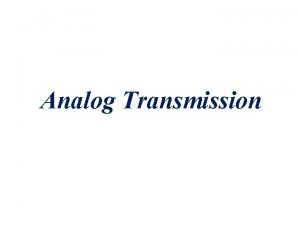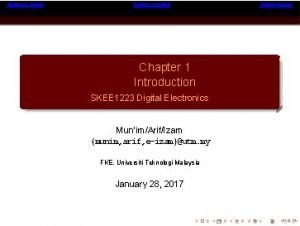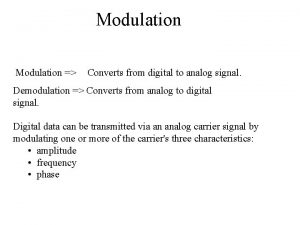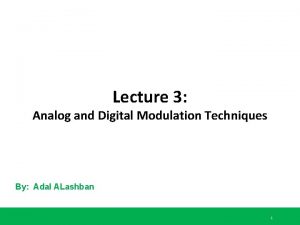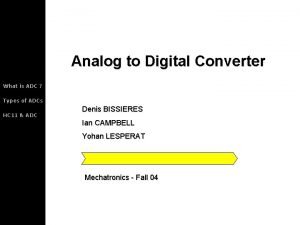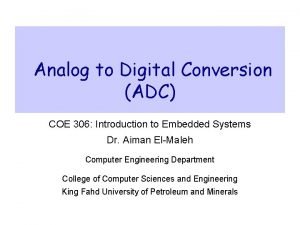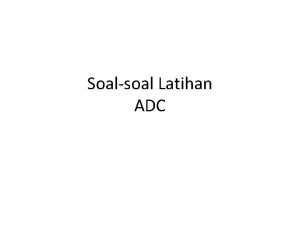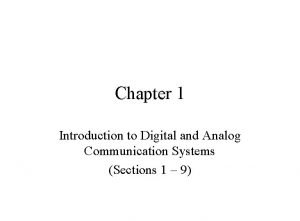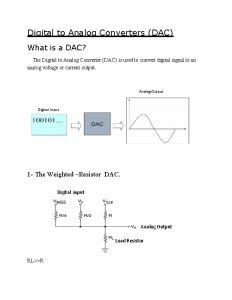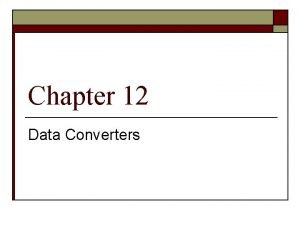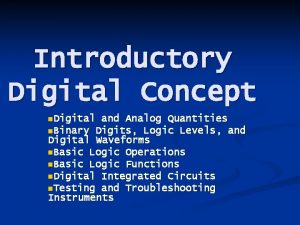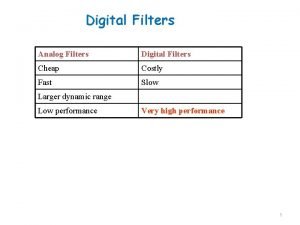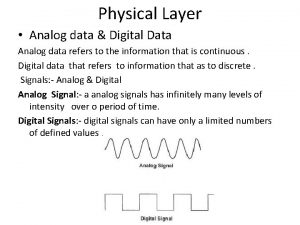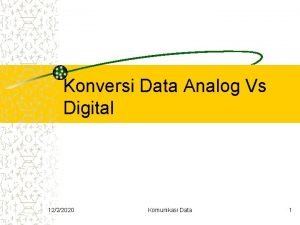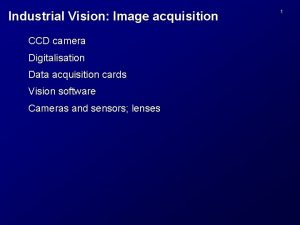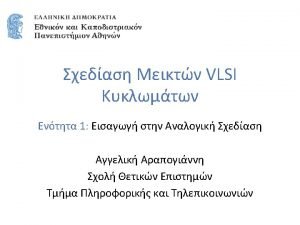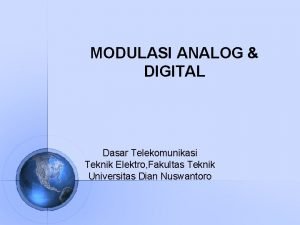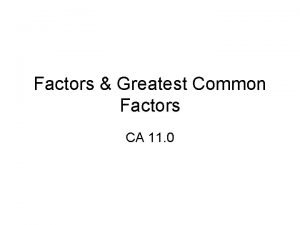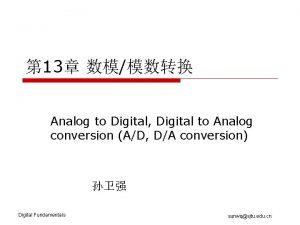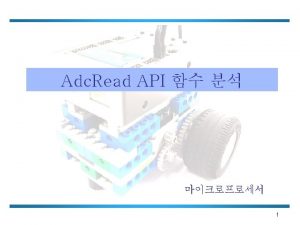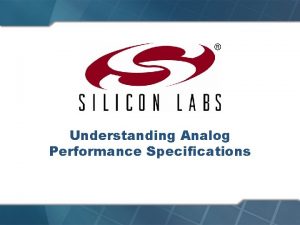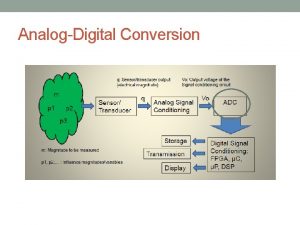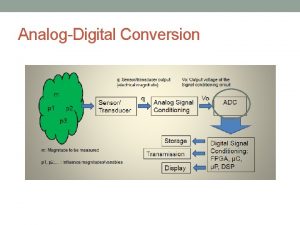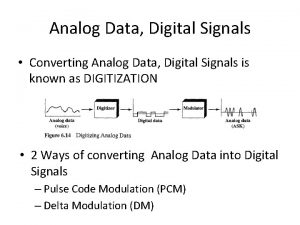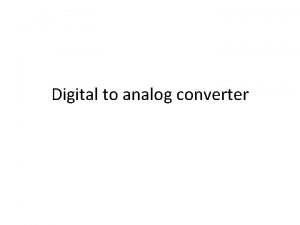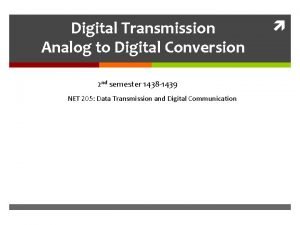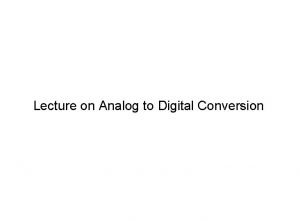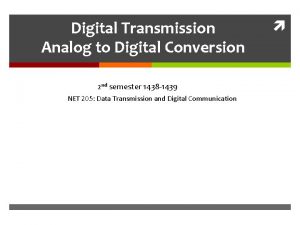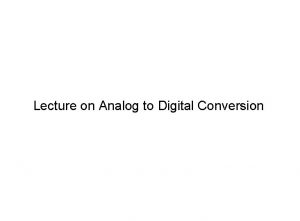Analog to Digital Conversion ADC COE 306 Introduction











































- Slides: 43

Analog to Digital Conversion (ADC) COE 306: Introduction to Embedded Systems Dr. Aiman El-Maleh Computer Engineering Department College of Computer Sciences and Engineering King Fahd University of Petroleum and Minerals

Next. . . v A/D Conversion Process v ADC Process Accuracy v Conversion Time & Converter Rate v Types of ADC Techniques Processes and Operating Systems slide 2 COE 306– Introduction to Embedded System– KFUPM

Signal Types Analog Signals v An analog signal is a continuous signal that contains time -varying quantities. Measures one quantity in terms of some other quantity. ² Example § in an analog audio signal, the instantaneous voltage of the signal varies continuously with the pressure of the sound t Processes and Operating Systems slide 3 COE 306– Introduction to Embedded System– KFUPM

Signal Types Digital Signals v A digital signal is a signal that is being used to represent data as a sequence of discrete values; at any given time it can only take on one of a finite number of values v The precision of the signal is determined by how many samples are recorded per unit of time Processes and Operating Systems slide 4 COE 306– Introduction to Embedded System– KFUPM

Analog-Digital Converter (ADC) v An electronic integrated circuit which converts a signal from analog (continuous) to digital (discrete) form v Provides a link between the analog world of transducers and the digital world of signal processing and data handling t Processes and Operating Systems slide 5 t COE 306– Introduction to Embedded System– KFUPM

A/D Conversion Process Two main steps: 1. Sampling and Holding 2. Quantization and Encoding Analog-to-Digital Converter Quantizing and Encoding Sampling and Hold t Input: Analog Signal Processes and Operating Systems slide 6 t COE 306– Introduction to Embedded System– KFUPM

A/D Conversion Process Sampling & Hold v Measuring analog signals at uniform time intervals ² Ideally twice as fast as what we are sampling t v Digital system works with discrete states ² Taking samples from each location v Reflects sampled and hold signal ² Digital approximation Processes and Operating Systems slide 7 COE 306– Introduction to Embedded System– KFUPM

A/D Conversion Process Quantizing v Separating the input signal into K discrete states Encoding v Assigning a unique digital code to each state v K=2 N ² N is the number of bits of the ADC v Analog quantization size ² Q=(Vmax-Vmin)/2 N ² Q is the Resolution Processes and Operating Systems slide 8 COE 306– Introduction to Embedded System– KFUPM

A/D Conversion Process v Quantization & Coding v Use original analog signal v Apply 2 bit coding v Apply 3 bit coding v Better representation of input information with additional bits Processes and Operating Systems slide 9 COE 306– Introduction to Embedded System– KFUPM

ADC Process-Accuracy Sampling Rate, Ts Resolution (bit depth), Q v Based on number of steps required in the conversion process v Improves accuracy in measuring amplitude of analog signal v Increases the maximum frequency that can be measured Processes and Operating Systems slide 10 COE 306– Introduction to Embedded System– KFUPM

ADC Process-Accuracy v Increasing sampling rate and the number of used quantized values result in better accuracy ADC signals. Processes and Operating Systems slide 11 COE 306– Introduction to Embedded System– KFUPM

ADC-Error Possibilities v Aliasing (sampling) ² Occurs when the input signal is changing much faster than the sample rate ² Should follow the Nyquist Rule when sampling § Use a sampling frequency at least twice as high as the maximum frequency in the signal to avoid aliasing § fsample>2*fsignal v Quantization Error (resolution) ² Optimize resolution ² Dependent on ADC converter of microcontoller Processes and Operating Systems slide 12 COE 306– Introduction to Embedded System– KFUPM

Aliasing Example Processes and Operating Systems slide 13 COE 306– Introduction to Embedded System– KFUPM

Quantization Error & Effective Number of Bits v Encoding a signal (A/2) sinwt with A being the full scale using n-bit ADC will give an error variance v Signal to Noise Ratio v Effective number of bits of an n-bit ADC ² n’ giving the correct SNR v Example: ² AD 9235 12 -bit 20 to 65 MHz ² SNR = 70 d. B ² Effective number of bits = 11. 4 Processes and Operating Systems slide 14 q e(x) COE 306– Introduction to Embedded System– KFUPM

Conversion Time & Converter Rate v Conversion Time ² Required time (tc) before the converter can provide valid output data v Converter Throughput Rate ² The number of times the input signal can be sampled maintaining full accuracy ² Inverse of the total time required for one successful conversion ² Inverse of Conversion time if No S/H(Sample and Hold) circuit is used v Input voltage change during the conversion process introduces an undesirable uncertainty v Full conversion accuracy is realized only if this uncertainty is kept low below the converter’s resolution Processes and Operating Systems slide 15 COE 306– Introduction to Embedded System– KFUPM

Conversion Time & Converter Rate v Rate of Change x tc resolution v Example ² 8 -bit ADC ² Conversion Time: 100 sec ² Sinusoidal input § Rate of change § Let FS = 2 A Limited to Low frequency of 12. 4 Hz Few Applications Processes and Operating Systems slide 16 COE 306– Introduction to Embedded System– KFUPM

Types of ADC Techniques v Counter or Tracking ADC v Flash ADC v Successive Approximation ADC v Single Slope Integration ADC v Dual Slope ADC v Delta-Sigma ADC Processes and Operating Systems slide 17 COE 306– Introduction to Embedded System– KFUPM

Counter Type ADC v Operation ² Reset and Start Counter ² DAC convert Digital output of Counter to Analog signal ² Compare Analog input and Output of DAC § Vi > VDAC – Continue counting § Vi ≤ VDAC – Stop counting ² Digital Output = Output of Counter v Disadvantage ² Conversion time is varied § 2 n Clock Period for Full Scale input Processes and Operating Systems slide 18 COE 306– Introduction to Embedded System– KFUPM

Tracking Type ADC v Tracking or Servo Type ² Using Up/Down Counter to track input signal continuously § For slow varying input Processes and Operating Systems slide 19 COE 306– Introduction to Embedded System– KFUPM

Flash ADC § Also known as parallel ADC § Elements • Priority Encoder – Converts output of comparators to binary • Comparators Processes and Operating Systems slide 20 COE 306– Introduction to Embedded System– KFUPM

Flash ADC v Processes and Operating Systems slide 21 COE 306– Introduction to Embedded System– KFUPM

Flash ADC v Example § Vin = 5. 5 V, Vref= 8 V § Vin lies in between Vcomp 5 & Vcomp 6 § Vcomp 5 = Vref*5/8 = 5 V § Vcomp 6 = Vref*6/8 = 6 V § Comparator 1 - 5 => output 1 § Comparator 6 - 7 => output 0 § Encoder Octal Input = sum(0011111) = 5 § Encoder Binary Output = 1 0 1 Processes and Operating Systems slide 22 COE 306– Introduction to Embedded System– KFUPM

Flash ADC v Typical performance: ² 4 to 12 bits ² 15 to 300 MHz ² High power v Half-Flash ADC ² 2 -step technique § 1 st flash conversion with 1/2 the precision § Subtracted with a DAC § New flash conversion Processes and Operating Systems slide 23 COE 306– Introduction to Embedded System– KFUPM

Half-Flash ADC v Example ² 4 -bit precision is divided into two stages with each stage generating 2 bits ² In the first stage, the comparators will be fed by the values 12/16 Vref, 8/16 Vref and 4/16 Vref => this will generate 2 bits ² The generated 2 bits will be converted to analog signal using DAC and then subtracted from the analog signal ² In the second stage, the comparators will be fed by the values 3/16 Vref, 2/16 Vref and 1/16 Vref Processes and Operating Systems slide 24 COE 306– Introduction to Embedded System– KFUPM

Flash ADC Advantages v Simplest in terms of operational theory v Most efficient in terms of speed, very fast § limited only in terms of comparator and gate propagation delays Processes and Operating Systems slide 25 Disadvantages v Lower precision v Expensive v For each additional output bit, the number of comparators is nearly doubled § i. e. for 8 bits, 255 comparators needed COE 306– Introduction to Embedded System– KFUPM

Successive Approximation ADC v Most Commonly used in medium to high speed Converters v Based on approximating the input signal with binary code and then successively revising this approximation until best approximation is achieved v SAR(Successive Approximation Register) holds the current binary value • DAC = Digital to Analog Converter • EOC = End of Conversion • SAR = Successive Approximation Register • S/H = Sample and Hold Circuit • Vin = Input Voltage • Comparator • Vref = Reference Voltage Processes and Operating Systems slide 26 COE 306– Introduction to Embedded System– KFUPM

Successive Approximation ADC v Uses an n-bit DAC and original analog results v Performs a binary comparison of VDAC and Vin v MSB is initialized at 1 for DAC v If Vin > VDAC (VREF / 2^1) then MSB is set to 1 otherwise 0 v If Vin > VDAC (VREF / 2^(n-i)) for bit i, bit i is set to 1 otherwise 0 v Algorithm is repeated up to LSB v At end DAC in = ADC out v N-bit conversion requires N comparison cycles Processes and Operating Systems slide 27 COE 306– Introduction to Embedded System– KFUPM

Successive Approximation ADC v Example DAC bit/voltage ² 5 -bit ADC, Vin=0. 6 V, Vref=1 V Bit 4 3 2 Voltage. 5. 25. 125 1 . 0625. 03125 § Cycle 1 => MSB=1 SAR = 1 0 0 VDAC = Vref/2^1 =. 5 Vin > VDAC SAR unchanged = 1 0 0 Vin < VDAC SAR bit 3 reset to 0 = 1 0 0 Vin < VDAC SAR bit 2 reset to 0 = 1 0 0 § Cycle 2 SAR = 1 1 0 0 0 VDAC =. 5 +. 25 =. 75 § Cycle 3 SAR = 1 0 0 VDAC =. 5 +. 125 =. 625 Processes and Operating Systems slide 28 0 COE 306– Introduction to Embedded System– KFUPM

Successive Approximation ADC § Cycle 4 SAR = 1 0 0 1 0 VDAC =. 5+. 0625=. 5625 Vin > VDAC SAR unchanged = 1 0 0 1 0 § Cycle 5 SAR = 1 0 0 1 1 VDAC =. 5+. 0625+. 03125=. 59375 Vin > VDAC Processes and Operating Systems slide 29 SAR unchanged = 1 0 0 1 1 COE 306– Introduction to Embedded System– KFUPM

Successive Approximation ADC v Example: -5 V to +5 V analog range, n=8 Processes and Operating Systems slide 30 COE 306– Introduction to Embedded System– KFUPM

Successive Approximation ADC Advantages Disadvantages v Capable of high speed and reliable v Higher precision successive approximation ADC’s will be slower ² Typical conversion time § 1 to 50 s ² Typical number of bits § 8 to 16 bits v Medium accuracy compared to other ADC types v Speed limited to ~5 Msps v Good tradeoff between speed and cost v Capable of outputting the binary number in serial (one bit at a time) format. Processes and Operating Systems slide 31 COE 306– Introduction to Embedded System– KFUPM

Single Slope Integration ADC v Start to charge a capacitor at constant current v Count clock ticks during this time v Stop when the capacitor voltage reaches the input v Cannot reach high precision ² capacitor ² comparator Processes and Operating Systems slide 32 COE 306– Introduction to Embedded System– KFUPM

Dual Slope ADC v Input voltage is applied to input of integrator and allowed to ramp for a fixed time period (tu) v Then, a known reference voltage of opposite polarity is applied to integrator and is allowed to ramp until integrator output returns to zero (td) v The input voltage is computed as a function of the reference voltage, the constant run-up time period, and the measured run-down time period Processes and Operating Systems slide 33 COE 306– Introduction to Embedded System– KFUPM

Dual Slope ADC v The run-down time measurement is usually made in units of the converter's clock, so longer integration times allow for higher precision v The speed of the converter can be improved by sacrificing precision v Advantages ² Capacitor value is not important although has to be of good quality v Typical precision ² 12 to 16 bit v Conversion time ² Depends on the clock frequency Processes and Operating Systems slide 34 COE 306– Introduction to Embedded System– KFUPM

Dual Slope ADC Advantages v Insensitive to errors in component values Disadvantages v Slow v Greater noise immunity than other ADC types v High precision external components required to achieve accuracy v High accuracy v Costly Processes and Operating Systems slide 35 COE 306– Introduction to Embedded System– KFUPM

Delta-Sigma ADC v Over sampled input signal goes to the integrator v Output of integration is compared to GND ² 1 if ≥ 0 otherwise 0 v Output is serial bit stream with # of 1’s proportional to Vin v 1 bit DAC generates +v if bit is 1 and –v if bit is 0 v Iteration drives integration of error to zero Processes and Operating Systems slide 36 COE 306– Introduction to Embedded System– KFUPM

Delta-Sigma ADC Processes and Operating Systems slide 37 COE 306– Introduction to Embedded System– KFUPM

Delta-Sigma ADC – Noise Shaping 1 st order Delta-Sigma 2 nd order Delta-Sigma Processes and Operating Systems slide 38 COE 306– Introduction to Embedded System– KFUPM

Outputs of Delta Sigma Modulator Input Out DAC 0. 4 v 1 +1 v 0. 8 v 1 +1 v 0. 4 v -0. 6 v -0. 2 v 0 -1 v 0. 8 v -0. 2 v 0. 6 v 1 +1 v 0. 4 v 1. 2 v 1 +1 v 0. 8 v -0. 2 v 0. 4 v 1 +1 v 0. 4 v -0. 6 v 1 +1 v 0. 8 v -0. 2 v 1 +1 v 0. 4 v -0. 6 v 0. 0 v 1 +1 v 0. 8 v -0. 2 v 0. 0 v 1 +1 v 0. 4 v -0. 6 v 0 -1 v 0. 8 v -0. 2 v 0 -1 v 0. 4 v 1. 4 v 0. 8 v 1 +1 v 0. 8 v 1. 6 v 1 +1 v 0. 4 v -0. 6 v 0. 2 v 1 +1 v 0. 8 v -0. 2 v 1. 4 v 1 +1 v 0. 4 v -0. 6 v -0. 4 v 0 -1 v 0. 8 v -0. 2 v 1. 2 1 +1 v 0. 4 v 1. 0 v 1 +1 v 0. 8 v -0. 2 v 1. 0 1 +1 v Average=0. 4 v Average=0. 8 v http: //www. analog. com/en/design-center/interactive-design-tools/sigma-delta-adc-tutorial. html Processes and Operating Systems slide 39 COE 306– Introduction to Embedded System– KFUPM

Outputs of Delta Sigma Modulator Processes and Operating Systems slide 40 COE 306– Introduction to Embedded System– KFUPM

Delta-Sigma ADC Advantages v High precision v Low cost Disadvantages v Slow due to oversampling v External sample & hold circuits are not required v Requirements for analog anti-aliasing filters are minimum Processes and Operating Systems slide 41 COE 306– Introduction to Embedded System– KFUPM

ADC Types Comparison Processes and Operating Systems slide 42 COE 306– Introduction to Embedded System– KFUPM

ADC Types Comparison Processes and Operating Systems slide 43 COE 306– Introduction to Embedded System– KFUPM
 Digital to analog conversion in data communication
Digital to analog conversion in data communication Introduction to analog and digital electronics
Introduction to analog and digital electronics Difference between analog and digital control system
Difference between analog and digital control system Introduction to digital control system
Introduction to digital control system Compare and contrast analog and digital forecasts
Compare and contrast analog and digital forecasts Perbedaan teknologi digital dan analog
Perbedaan teknologi digital dan analog Analog and digital transmission
Analog and digital transmission Analog v digital
Analog v digital Modulation digital to analog
Modulation digital to analog Disadvantages of fsk
Disadvantages of fsk Analog and digital video in multimedia
Analog and digital video in multimedia Analog vs digital
Analog vs digital Perbedaan analog dan digital
Perbedaan analog dan digital Types of analogue to digital converter
Types of analogue to digital converter Adc types
Adc types Kepanjangan adc
Kepanjangan adc Contoh soal data analog dan digital
Contoh soal data analog dan digital Rtv 332
Rtv 332 Digital signal as a composite analog signal
Digital signal as a composite analog signal Analog vs digital communication systems
Analog vs digital communication systems Analog image and digital image
Analog image and digital image Kelebihan modulasi digital dibandingkan modulasi analog
Kelebihan modulasi digital dibandingkan modulasi analog Digital to analog converter
Digital to analog converter Analog and digital signals in computer networking
Analog and digital signals in computer networking Digital to analog converters basic concepts
Digital to analog converters basic concepts Analog vs digital video
Analog vs digital video Digital and analog quantities
Digital and analog quantities Analog encoding
Analog encoding Filter lpf hpf bpf brf
Filter lpf hpf bpf brf Analog signla
Analog signla Analog vs digital
Analog vs digital Kelebihan elektronika analog adalah .
Kelebihan elektronika analog adalah . Compare analog and digital filters
Compare analog and digital filters Digital image acquisition for analog sem
Digital image acquisition for analog sem Razavi cmos analog circuit design
Razavi cmos analog circuit design Compare and contrast analog and digital forecasting
Compare and contrast analog and digital forecasting Modulasi adalah
Modulasi adalah National general core value plan
National general core value plan Highest common factor
Highest common factor Ecologist
Ecologist Operations management lecture notes doc
Operations management lecture notes doc Troop 306
Troop 306 Ed 306
Ed 306 Reflexión sobre las virtudes teologales
Reflexión sobre las virtudes teologales
